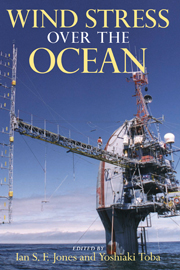Book contents
- Frontmatter
- Contents
- Preface
- Acknowledgements
- Contributors
- Frequently Used Symbols
- 1 Overview
- PART 1
- PART 2
- 8 The Influence of Swell on the Drag
- 9 The Influence of Unsteadiness
- 10 The Dependence on Wave Age
- 11 The Influence of Mesoscale Atmospheric Processes
- 12 Wind, Stress and Wave Directions
- 13 The Influence of Surface Tension
- 14 The Influence of Spatial Inhomogeneity: Fronts and Current Boundaries
- 15 Basin Boundaries
- References
- Index
9 - The Influence of Unsteadiness
Published online by Cambridge University Press: 16 October 2009
- Frontmatter
- Contents
- Preface
- Acknowledgements
- Contributors
- Frequently Used Symbols
- 1 Overview
- PART 1
- PART 2
- 8 The Influence of Swell on the Drag
- 9 The Influence of Unsteadiness
- 10 The Dependence on Wave Age
- 11 The Influence of Mesoscale Atmospheric Processes
- 12 Wind, Stress and Wave Directions
- 13 The Influence of Surface Tension
- 14 The Influence of Spatial Inhomogeneity: Fronts and Current Boundaries
- 15 Basin Boundaries
- References
- Index
Summary
Introduction
The boundary layers each side of the sea surface are forced on many time and space scales. To simplify matters, the previous chapters described situations where the external forcing was constant. However the measurements presented from the natural environment were subjected to variations in forcing conditions. Observations yielded many different values of neutral atmosphere drag coefficient. While there are some trends (in Fig. 1.4 for instance), that can be attributed to different wind speed, much of the variability remains unexplained. Could some of the remaining variability result from the unsteady nature of the boundary layers each side of the air–sea interface?
The air–sea interface is a coupled system. The momentum transfer between them occurs through the sea surface which is distorted by wind-waves. These are not the idealized irrotational gravity and capillary waves but are the turbulent windsea motions induced by the sheared boundary layers. The waves play a special role in the momentum transfer between the sheared air and water boundary layers, as discussed in Section 4.5.4. The time scales typical of the air and water boundary layers need to be compared with the response time of the windsea to assess the interactions. With some understanding of these time scales, the influence of unsteadiness on the momentum flux at the sea surface can be examined. The spatial variations in the boundary layers are swept past a stationary observer who may interpret the variations as temporal change.
- Type
- Chapter
- Information
- Wind Stress over the Ocean , pp. 190 - 205Publisher: Cambridge University PressPrint publication year: 2001
- 2
- Cited by



